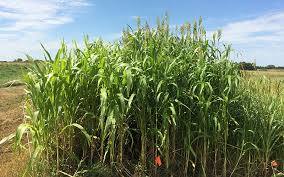History Of Plant Breeding – Agriculture Notes – For W.B.C.S. Examination.
It is commonly held that agriculture arose at as many as nine different locations scattered around the globe, independently of each other. These agricultural origins essentially mirror Vavilov’s originally proposed “centers of origin.” These centers of origin are the places where Vavilov suggested the currently cultivated crop species were originally domesticated from the wild type (Vavilov, 1926).Continue Reading History Of Plant Breeding – Agriculture Notes – For W.B.C.S. Examination.
It is from these centers that domesticated plants and agriculture first spread. The spread of this new technology would have been a slow process. It is unlikely that wholly nomadic peoples converted to sedentary agricultural systems over-night. It is more likely that the transition was a slow one, involving both methods together for quite some time before finally settling down into a wholly agrarian existence (Smith, 2001a; Smith, 2001b).
These new methods and new plants would have spread faster going east or west across the globe from their origin. This east/west spread was easier due largely to plant adaptability to climate (Diamond, 1997). As was found to be the case in Africa, the spread north or south was more difficult due to climate adaptation (Marshall and Hildebrand, 2002). Cohen et al. (1984) suggest that the beginnings of agriculture would have resulted in decreased fitness for adherents to the new method. This could very well be the case for groups who were forced to switch from an entirely hunter-gatherer existence to an entirely agricultural existence due to lack of prey animals or some catastrophe. The agricultural outputs would have struggled to catch up with necessity. In an experiment to test the difficulty of harvesting wild grains by hand, one researcher went to a naturally occurring stand of wild wheat in Turkey.
He demonstrated that a person could easily harvest a year’s supply of grain in just a couple of weeks using nothing but their hands, and considerably more grain with a hand-held sickle made of flint (Harlan, 1967). So, given a shortfall in the productivity of a certain environ, it would have been quite easy to harvest sufficient food from the plant-scape of one’s environment. The limiting factor would be knowledge of which plants to taste or eat. Once the knowledge hurdle was crossed, the idea would have spread quickly within and without camps.
Importance
The domestication of the plant and the subsequent development of agriculture allowed people to set down permanent roots and develop the rich cultures that led to our existence. With agriculture came the production of excess food and sedentary villages that were hitherto unobtainable. The excess of food, and the decrease in time required to spend foraging, lead to a division of labor, the development of such things as art and science, and gave birth to modern civilization (Diamond, 2002). Population growth, thought to be a contributing factor to the development of agriculture, was also a consequence of agriculture’s increased sedentism (Lee, 1980). Fortunately, more people could be sustained by a smaller land area with agriculture than before.
Consequences of Domestication
Few plant species, of the thousands of possibilities, were ever domesticated for food, fiber, or other human use. In the immensely popular book, “Guns, Germs and Steel: The Fates of Human Societies”, Diamond (1997) cites a simple explanation for the domestication of this small percentage of available species. His basic hypothesis is that these species were used for their ease of breeding for those traits that made them useful plants. That is, the traits which made some plants desirable to the early plant breeders/domesticators were controlled by few genes (Diamond, 1997). This idea is supported by a great deal of molecular work discussed later in this paper. This is interesting, and answers some very important questions. An example of this simple inheritance of important agricultural traits is the shattering system in wheat and barley.
The mechanism by which wheat and barley scatter their seeds at maturity is controlled by a single gene. When man selected for the non-shattering type wheat, the trait was fixed quickly and easily, making the crop preferable to others that might have been candidates (Zohary and Hopf, 1988). It is obvious that our early ancestors would have preferred these cereals to all others simply because the grain stayed on the plant longer, and so the harvest window was longer than others.
It seems that crop species were not necessarily selected, but serendipitously discovered because they did not need much tinkering to become valuable food sources and agricultural models. The leap from useless weed to valuable food source was short and relatively easy. Almonds provide another example of simple inheritance of beneficial traits. The wild progenitors of almonds contained bitter chemicals to fend off predators, however, the mutation that makes the distasteful compounds absent is a single gene system and as such was easy to select. Oak tree acorns, on the other hand, have similar distasteful compounds within them, but the trait is a polygenic trait, making selection difficult, especially for the unwitting plant breeders of antiquity, which might explain why oak trees have never been domesticated (Diamond, 1997).
Please subscribe here to get all future updates on this post/page/category/website


 +919674493673
+919674493673  mailus@wbcsmadeeasy.in
mailus@wbcsmadeeasy.in







































































































